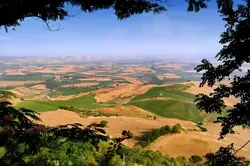 |
|---|
FOOD AND WINE
A journey into the food and wine of Termoli and Molise in general, characterized by delicious traditional excellences such as cured meats, cheeses, oils, wines and characteristic desserts.



Gastronomy
The Termoli gastronomy is typically seafood-based, but makes extensive use of the oil produced on the nearby hills. The typical dish par excellence is u' bredette alla termolese, an evening meal for fishermen returning home from fishing.
Other typical dishes are:
Pasta alla guitar with cuttlefish and/or calamari sauce;
Fesille (fusilli with plain vegetable sauces or tomato sauce);
The sécce (cuttlefish) and 'pisille;
The pulepe 'mbregatorie (the octopuses "in purgatory");
The trejje (mullets) alla 'ngorde (greedy);
The trejjezzole (very small mullets);
U pappòne (the pimp);
A mertiscene (the torpedo);
The tubettini with 'i maruzzelle (pasta [tubetti] with sea snails);
Pulepe arrecciate (octopus with olive oil in a pan);
U shiscille;
Christmas scarpelle: leavened and fried bread dough;
Cacate de ciavele: small balls of fried dough covered in honey.


Molise wines
What are Molise wines?
The most cultivated vines in Molise are the red grape varieties, such as Montepulciano, Sangiovese and Tintilia. Ciliegiolo, Merlot, Barbera, Cabernet Sauvignon and Aglianico are also popular.
Among the white grape varieties, the most cultivated ones are Trebbiano Abruzzese and Trebbiano Toscano, followed by Manzoni Bianco, Malvasia di Candia, Pinot Bianco, Chardonnay, Malvasia Bianca, Bombino Bianco, Moscato Bianco, Pinot Grigio, Riesling, Sylvaner, Gewürztraminer, Garganega and sauvignon blanc.
What are the DOCs of Molise? What is the best wine from Molise?
Molise has 4 Controlled Designations of Origin (DOC).
In Alto Molise, in the province of Campobasso, which represents the area with the oldest winemaking tradition, we find the DOC Biferno, produced in the red and rosé versions - from Montepulciano and Aglianico grapes - and white, from Trebbiano Toscano grapes.
In Lower Molise, in the province of Isernia, an area that has seen a more recent development in the cultivation of vines, there is the DOC Pentro d'Isernia, also produced in three versions: red and rosé, from Montepulciano and Tintilia grapes, and white from Tuscan Trebbiano and white Bombino.
Finally, throughout the territory, the Molise DOC are produced, in the 4 types of red, white, rosé and sparkling wine, and Tintilia del Molise, in the red and rosé versions, both from Tintilia grapes.




